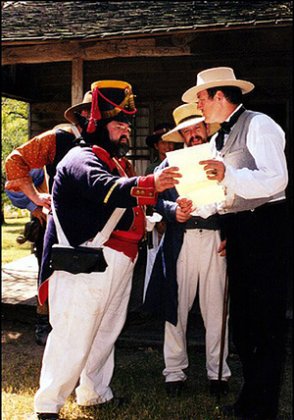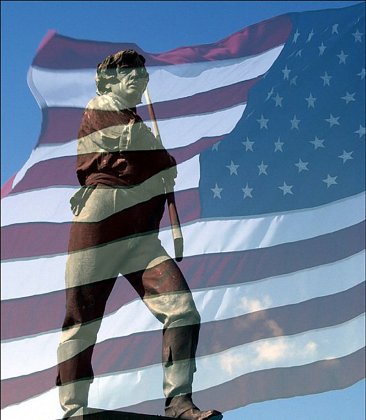Newspapers document Texas Revolution
Personal letters and orders from commanders
By Murray Montgomery
Staff Writer
Over the years, there has been so much written about the Texas Revolution that some folks might get tired of hearing the same old story. I guess that I’ve been a little different in my approach to the subject. As a writer and would-be historian, I’ve done a lot of research about that period in our history. However, I tend to want to know more about the men in the ranks who fought in that war – Texans and Mexicans alike.
We need to remember those who were fighting, sometimes hand-to-hand, during the battles. There’s no doubt that Travis, Crockett, and Bowie were heroes but others who fought should also be acknowledged. In movies that I’ve watched about the Alamo, Goliad, and San Jacinto; I don’t recall seeing much about the regular soldier in either army.
While I like John Wayne, his movie about the Alamo was, in my opinion, the least historically accurate. Most made-for-television movies have the same characteristics when it comes to telling the real story. If you wish to watch a movie that’s closer to the way it was, check out “The Last Command” – it’s an old one, but fairly accurate.
As I was looking for information to put in this column, I came across my favorite source; old newspapers. I was amazed that they were still readable because of their age. However, they were in better shape than some modern papers that are on microfilm.
I’m going to share some excerpts that were found in newspapers from 1832 and 1836 – any of these that are directly from the articles will be surrounded by quotation marks.
General Sam Houston was on his way to reinforce the Alamo and was in Gonzales when the news came that the battle was over and the defenders were all dead. Knowing that his men would be no match for the battle-tested soldiers of the Mexican army, Houston ordered a retreat.
History tells us that he gave orders for Gonzales to be burned to the ground. As the retreat started east toward the Colorado River, refugees fleeing from Santa Anna’s army joined the retreat – thus began the Runaway Scrape.
According to the Handbook of Texas, “The flight was marked by lack of preparation and panic caused by fear both of the Mexican army and of the Indians.” Also, the refugees were hindered by diseases, and the rain, cold, and hunger added to their troubles. Many died and were buried where they fell.
What follows is quotes from several newspapers, before and after the revolution. This one is from the Telegraph and Texas Register printed in Columbia on August 23, 1836. Keep in mind that they wrote very differently back then - I’ve tried to make the quotes a little easier to read.
“ORDINANCE - [Volunteers] have earned our warmest gratitude: Therefore resolved, That bounties of land be granted, and are hereby granted to said volunteers, as follows, to wit: To all who are now in service, and shall continue in service faithfully during the war, twelve hundred and eighty acres. To all who have served faithfully, or who shall have served faithfully, for a period not less than six months, six hundred and forty acres.”
On March 3, 1836, the letter below was written by William B. Travis - it was addressed to a “friend.” The Alamo fell on March 6, so chances are this is one of the last letters to be sent from behind the walls.
“Dear Sir-do me the favor to send the enclosed to its proper destination instantly. I am still here, in fine spirits, and well to do. With 140 men I have held this place; I have sent a force of near 200 men on 10 days against a force variously estimated the west side of the river. In a few days from 1500 to 6000, and I shall continue to I hope to have force sufficient to capture hold it till I get relief from my countrymen, the enemy before he can reach the [Guadalupe] or I will perish in its defense. We have had a shower of bombs and cannon balls continually falling among us the whole time, yet none of us have fallen. We have been miraculously preserved. God Bless you, William B. Travis.”
Finally, there was another article that appeared in the same issue of the Telegraph and Texas Record. It seems Sam Houston was dealing with deserters. The following order was issued on March 2, 1836.
ARMY ORDERS
“Head Quarters, Camp near Beason’s, March 2, 1836.
I had not traveled far before I met five others, inquiring for the before mentioned expresses, wishing to know how far they were ahead. I remarked it took a great many to [yield] in that direction. I concluded that they were from the army, and was surprised that men would leave the field at this time to provide for the safety of property or families while our army was so far in advance. I will take such immediate measures and will arrest the deserters from the army and all persons leaving the country. SAM HOUSTON, Commander-in-Chief.”
I hope these excerpts give you some idea of what people were dealing back then. Not only did they have to worry about dying, but they were also dealing with the day-to-day operation of an army that was out-gunned by a superior enemy force. However, they did their duty and the new Republic of Texas was born.



